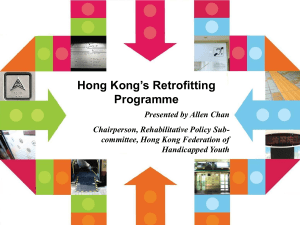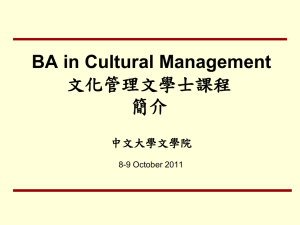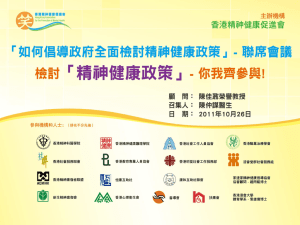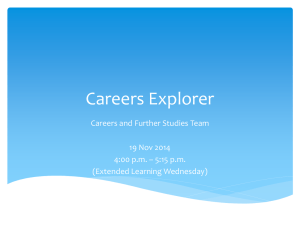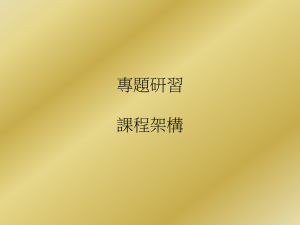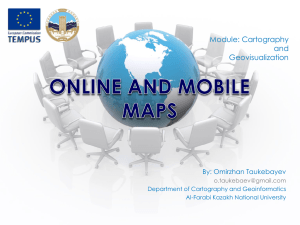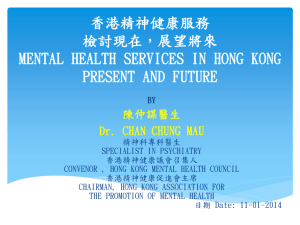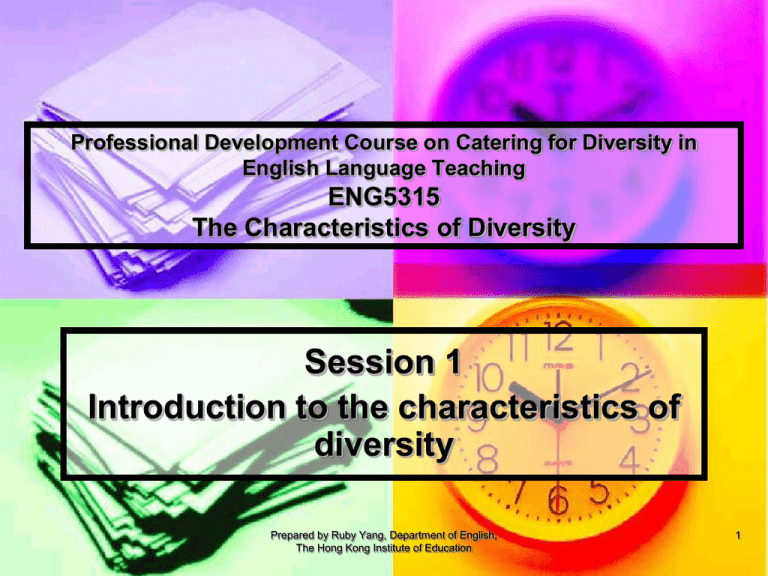
Professional Development Course on Catering for Diversity in
English Language Teaching
ENG5315
The Characteristics of Diversity
Session 1
Introduction to the characteristics of
diversity
Prepared by Ruby Yang, Department of English,
The Hong Kong Institute of Education
1
What is diversity?
Diversity means ‘differences’.
Differences from what?
Prepared by Ruby Yang, Department of English,
The Hong Kong Institute of Education
2
Challenges to diversity
Prejudice and discrimination
Stereotypes
Ethnocentrism
Prepared by Ruby Yang, Department of English,
The Hong Kong Institute of Education
3
Activity 1 - Mini-survey
What is the racial/ethnic background of the students
in your English class?
Nationalities
Number
Hong Kong Chinese
Mainland Chinese (e.g. new
immigrants and cross boundary
students)
Indian
Pakistani
Nepalese
Others (including British, American,
Australian, Canadian, etc.)
Prepared by Ruby Yang, Department of English,
The Hong Kong Institute of Education
4
Important questions to consider
Why cultural diversity matters for schools
and education?
Why is it important for teachers to be aware
of racial, ethnic, and cultural diversity?
Prepared by Ruby Yang, Department of English,
The Hong Kong Institute of Education
5
Why cultural diversity matters
for schools and education?
A more lasting rationale for cultural
diversity in education is that educators can
use this idea to promote equity.
Prepared by Ruby Yang, Department of English,
The Hong Kong Institute of Education
6
How to become a culturally
responsive educator?
In order for teachers to provide an effective
multicultural curriculum for culturally and
linguistically diverse (CLDE) students, it is
necessary for them to become culturally
competent.
Prepared by Ruby Yang, Department of English,
The Hong Kong Institute of Education
7
How to become a culturally
responsive educator?
Culturally competent teachers possess
self-awareness and self-understanding,
cultural awareness and understanding, and
social responsiveness and responsibility
and are able to provide appropriate
teaching techniques and strategies. They
recognize the differences between their
students and themselves and strive to
become non-judgmental (Cartledge,
Gardner, & Ford, 2009).
Prepared by Ruby Yang, Department of English,
The Hong Kong Institute of Education
8
How to become a culturally
responsive educator?
Culturally competent teachers develop
meaningful relationships with their students
of color. They demonstrate social
responsiveness and responsibility by
increasing racial harmony within their
classrooms, decreasing the negative
beliefs and attitudes toward minority
students, and demanding respect for
individual differences (Ford & Milner, 2005).
Prepared by Ruby Yang, Department of English,
The Hong Kong Institute of Education
9
Storti’s model of cultural
competence
Incompetence
Unconscious
Conscious
Competence
Blissful Ignorance
Level 1
You are not aware that cultural differences
exist between you and another person.
It doe not occur to you that you may be
misinterpreting much of the behavior going
on around you.
Spontaneous Sensitively
Level 4
You no longer have to think about
what you are doing in order to be
culturally sensitive (in a culture you
know well). Culturally appropriate
behavior comes naturally to you,
and you trust your intuition because
it has been reconditioned by what
you know about cross-culturally
interactions.
Troubling Ignorance
Level 2
You realize that there are cultural differences
between you and another person, but you
understand very little about these
differences. You know there’s a problem, but
don’t know the magnitude of it. You are
worried about whether you’ll ever figure out
these differences in others.
Deliberate Sensitivity
Level 3
You know there are cultural
differences between people, you
know some of the differences, and
you try to modify your own behavior
to be sensitive to these differences.
This does not come naturally, but
you make a conscious effort to
behave in culturally sensitive ways.
You are in the process of replacing
old intuitions with new ones.
Prepared by Ruby Yang, Department of English,
The Hong Kong Institute of Education
10
Activity 2 - Storti’s model of
cultural competence
Which level of the model do you belong to?
Compare it with the participant(s) sitting
next to you. Is it the same or different?
Prepared by Ruby Yang, Department of English,
The Hong Kong Institute of Education
11
Activity 3 - Discussion
With our schools/classrooms become
more culturally diverse than before, what
challenges might we, as English teachers,
face?
What can teachers do to address cultural
diversity?
Prepared by Ruby Yang, Department of English,
The Hong Kong Institute of Education
12
Pedagogical responses to
cultural diversity
“Having all children together is better.”
(Taylor, 1971, cited in Murillo & Smith,
2008)
13
Pedagogical responses to
cultural diversity
Assimilation
14
Pedagogical responses to
cultural diversity
Multicultural education
Multicultural education incorporates the
ideas that “all students – regardless of their
gender, social class and their ethnic, racial
or cultural characteristics – should have an
equal opportunities to learn in school”
(Banks, 2005, p. 3).
One major dimension of multicultural
education is content integration
Prepared by Ruby Yang, Department of English,
The Hong Kong Institute of Education
15
Diverse learners with
exceptionalities
Exceptional learners include both special
education students and gifted education
students (Cartledge, Gardner, & Ford,
2009).
Prepared by Ruby Yang, Department of English,
The Hong Kong Institute of Education
16
Scope of special education
Special education includes all students
who need specialized instruction.
Prepared by Ruby Yang, Department of English,
The Hong Kong Institute of Education
17
Learning difficulties vs. specific
learning disabilities (SLDs)
The term ‘learning difficulty’ is normally
applied to pupils who are not making
sufficient progress particularly in basic
skills such as literacy and numeracy (Ayers,
2006).
The SEN Code of Practice defines children
as having learning difficulties if they have
difficulties in learning that are greater than
most children in their age group, and if they
have difficulties which prevent them from
using educational facilities in a school.
Prepared by Ruby Yang, Department of English,
The Hong Kong Institute of Education
18
Learning difficulties vs. specific
learning disabilities (SLDs)
A specific learning disability (SLD) is a
disorder in one or more of the basic
psychological processes involved in
understanding or in using language,
spoken or written, which may manifest in
an imperfect ability to listen, think, speak,
read, write, spell, or do mathematical
calculations (Cartledge, Gardner, & Ford,
2009).
A pupil has a specific learning difficulty in a
particular curricular area but functions
normally in other parts of the curriculum
(Ayers, 2006).
Prepared by Ruby Yang, Department of English,
The Hong Kong Institute of Education
19
Major types of learning
disabilities
Disorders of spoken language (listening and
speaking)
Aphasia / Dysphasia
Loss or impairment of the ability to use
language.
Dysarthria
A speech impairment contributes to
unintelligibility in that the quality of the
vocal output is affected adversely (Myers
& Hammill, 1990).
Prepared by Ruby Yang, Department of English,
The Hong Kong Institute of Education
20
Major types of learning
disabilities
Disorders of written language (reading and
writing)
Dyslexia
A reading disability
Dysgraphia
Difficulty with writing
Prepared by Ruby Yang, Department of English,
The Hong Kong Institute of Education
21
Major types of learning
disabilities
Attention deficit disorders
Attention deficit disorder (ADD) /
Attention deficit hyperactivity
disorder (ADHD)
According to DSM III, the criteria for the
diagnosis of attention deficit disorder
with hyperactivity are: inattention,
impulsivity, and hyperactivity (Myers &
Hammill, 1990).
Prepared by Ruby Yang, Department of English,
The Hong Kong Institute of Education
22
Major types of learning
disabilities
Perceptual disorders
Perceptual and perceptual-motor
disorders
Impairments of discriminating or
recognizing auditory and visual stimuli
Poor time, space, or distance orientation
Poor left-right orientation
Poor eye-hand coordination (Myers &
Hammill, 1990)
Prepared by Ruby Yang, Department of English,
The Hong Kong Institute of Education
23
Major types of learning
disabilities
Motor disorders
Dyspraxia
Poor motor coordination
Prepared by Ruby Yang, Department of English,
The Hong Kong Institute of Education
24
Major types of learning
disabilities
Disorders of arithmetic
Dyscalculia
Problems related to performing the
various arithmetic functions or operations.
Prepared by Ruby Yang, Department of English,
The Hong Kong Institute of Education
25
Some facts of learning
disabilities
Intelligence
Generally speaking, people with learning
disabilities are of average or above average
intelligence.
Prepared by Ruby Yang, Department of English,
The Hong Kong Institute of Education
26
Some facts of learning
disabilities
Gender
Researchers and practitioners have noted
a disproportionate number of boys
identified as having learning disabilities
(Hallahan, Lloyd, Kauffman, Weiss, &
Martinez, 2005).
Prepared by Ruby Yang, Department of English,
The Hong Kong Institute of Education
27
Frequently displayed symptoms
of learning disabilities
Short attention span
Poor memory
Difficulty following directions
Inability to discriminate between/among
letters or sounds
Poor reading and/or writing ability
Eye-hand coordination problems; poorly
coordinated
Difficulties with sequencing
Disorganization and other sensory
difficulties (Learning Disabilities Association
of America, 2004)
Prepared by Ruby Yang, Department of English,
The Hong Kong Institute of Education
28
Other characteristics of students
with learning disabilities
Low self-concept
Not socially accepted (Bender, 2008)
Prepared by Ruby Yang, Department of English,
The Hong Kong Institute of Education
29
References
Ayers, H. (2006). An A to Z practical guide to learning
difficulties. London: David Fulton.
Banks, J. A. (2005). Multicultural education: Characteristics and
goals. In J. A. Banks & C. A. M. Banks (Eds.), Multicultural
education: Issues and perspectives (5th ed) (pp. 3-30).
Hoboken, NJ: Wiley.
Bender, W. N. (2008). Learning disabilities: Characteristics.
identification, and teaching strategies. Boston, Mass.; Hong
Kong: Pearson/Allyn and Bacon.
Cartledge, G., Gardner, R., & Ford, D. Y. (2009). Diverse
learners with exceptionalities: Culturally responsive teaching
in the inclusive classroom. Upper Saddle River, N.J.:
Pearson Prentice Hall.
Ford, D. Y. & Milner, H. R. (2005). Teaching culturally diverse
gifted students. Waco, TX: Prufrock Press.
Hallahan, D. P., Lloyd, J. W., Kauffman, J. M., Weiss, M., &
Martinez, E. A. (2005). Learning disabilities: Foundations,
characteristics, and effective teaching. Boston, Mass.:
Pearson/Allyn and Bacon.
Prepared by Ruby Yang, Department of English,
The Hong Kong Institute of Education
30
References
Learning Disabilities Association of America. (2004). Learning
disabilities: Signs, symptoms and strategies. Retrieved
March 28, 2008, from http://www.ldaamerica.org/
Manning, M. L. & Baruth, L. G. (2009). Multicultural education
for children and adolescents (5th ed). Boston, Mass.; Hong
Kong: Pearson/Allyn and Bacon.
Murillo, L. A. & Smith, P. H. (2008). Cultural diversity: Why it
matters in school and what teachers need to know. In Y. S.
Freeman, D. E. Freeman, & R. Ramirez (Eds.), Diverse
learners in the mainstream classroom: Strategies for
supporting all students across content areas (pp. 3-30).
Portsmouth, N.H.: Heinemann.
Myers, P. I., & Hammill, D. D. (1990). Learning disabilities:
Basic concepts, assessment practices, and instructional
strategies. Austin, Tex.: PRO-ED.
Rubalcava, M. (1991). Locating transformative teaching in
multicultural education. Unpublished manuscript. Berkeley,
University of California, Department of Anthropology,
Special Project.
Prepared by Ruby Yang, Department of English,
The Hong Kong Institute of Education
31
Activity 4
Read the six cases given carefully. Try to
identify the characteristics of learning
difficulties of the six learners and determine
their possible learning disabilities.
Prepared by Ruby Yang, Department of English,
The Hong Kong Institute of Education
32
Discussion
With the new MOI policy being
implemented in Hong Kong schools, do
you think if the problem of learner diversity
can be solved? If not, what are the
problems you, as an English teacher, are
currently encountering?


